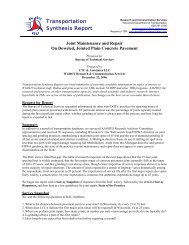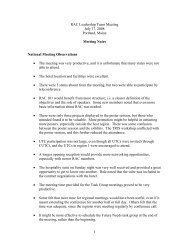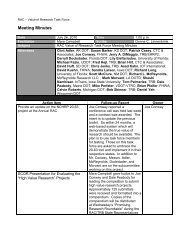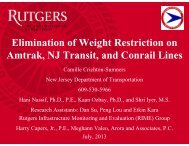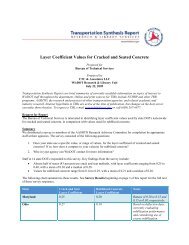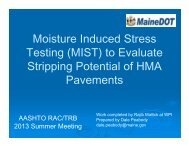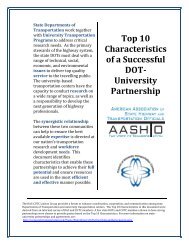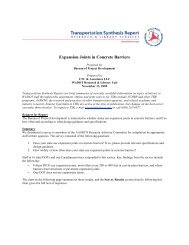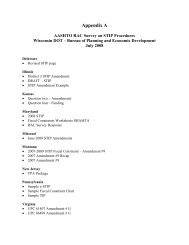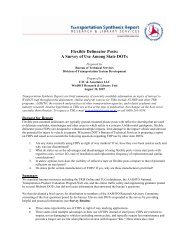PART IV: Summary of Comments - SCOR/RAC
PART IV: Summary of Comments - SCOR/RAC
PART IV: Summary of Comments - SCOR/RAC
Create successful ePaper yourself
Turn your PDF publications into a flip-book with our unique Google optimized e-Paper software.
<strong>PART</strong> <strong>IV</strong>: <strong>Summary</strong> <strong>of</strong> <strong>Comments</strong>17-May-10Reviewer <strong>Comments</strong> Distribution <strong>of</strong> RatingsResearch Advisory Committee■ North Carolina has been utilizing CMFs for safety project decisions for several years and probably has as much expertisebetween our Headquarters Safety Staff and our Regional staff as any other state. The key for success in North Carolinawill be the ability to carry the same proven (safety project) approach over to more Department (TIP/RRR/RRRR andMaintenance ) project investments and efforts. The possibility for our use in North Carolina beyond just spot safety andhazard elimination projects raises the potential value <strong>of</strong> this research project. ■ The HSM is an important document that will be coming out and affect a large portion <strong>of</strong> safety decisions. This is a peerexchange and process to develop an implementation guide. This is something that will be beneficial nationally and it isuseful to know how other State DOTs are implementing safety programs.■ The HSM is an important body <strong>of</strong> work that should <strong>of</strong>fer major advancements in safety. The costs appear to bereasonable.■ After substantial funding from NCHRP and FHWA and delays since late 2008, AASHTO expects to publish theHighway Safety Manual (HSM) in the Spring <strong>of</strong> 2010. With the publishing date so close, work in this area is urgent.The HSM will provide useful information and tools in making decisions about highway planning and design. The HSMwas first discussed 10 years ago within TRB, and it has now been determined that the absence <strong>of</strong>, and the need for asingle, authoritative document to use for estimating safety impacts. The National Cooperative Research Programcurrently has a project (NCHRP Project 17-36) underway to produce the first edition <strong>of</strong> the Highway Safety Manual.There will be training materials, including “Train-the-Trainer” available upon the HSM release. The HSM is a guidancedocument, not a formal policy document. The HSM will co-exist with other documents and is evolving along with legalconcerns and considerations. With any new process, this project may be subject to significant scrutiny and resistance butwill help assure that highway agencies are implementing and benefiting from the experiences and lessons learned by thelead states initiative.■ The HSM is an important document for those in the safety field.Item #25:A-01Transportation Investments and the Economy:Broadening the Scope and Enhancing the Methodology(17)(46)NR 0 1 2 3 4 5<strong>SCOR</strong> 3 5 3 6<strong>RAC</strong> 1 2 2 7 9 14 14Standing Committee on Research■ Pro: A subject <strong>of</strong> intense interest. Con: Probability <strong>of</strong> breaking fresh ground is tiny. The list <strong>of</strong> serious contenders for thiscontract is short, all firms who have won recent past NCHRP projects on more-or-less closely related topics. Withrespect to Phase I: It’s out there already. With respect to Phase II: It’s suggested here that benefits are measured toonarrowly in standard BCAs <strong>of</strong> transportation investments (TIs). But if benefits are expanded, costs must also be scaledup proportionally. E.g., where the proposal says the benefits to freight will be included in the BCA <strong>of</strong> TIs, are we tounderstand that the full costs imposed by freight (i.e. accelerated wear <strong>of</strong> pavements and more frequent maintenanceexpenses) will also be included? Expanding only benefits would make the outcome <strong>of</strong> a BCA less credible. Bottom line:freight traffic reaps major benefits and imposes major costs on the transportation system. Enlarge both or neither inBCAs <strong>of</strong> TIs. ■ Phase 1 only @ 75,000. There appears to be other studies in progress■ Too many important issues lumped into one project.■ Economic valuation, freight benefits, and greenhouse gas emissions are not adequately accounted for in currentbenefit/cost assessments. Better inclusion <strong>of</strong> these three elements into transportation investment analyses is needed. Theresults <strong>of</strong> Phase 2 could be quite useful to transportation decision makers throughout the nation. ■ The scope is too broad. Better to try a fewer things and do them well. Greenhouse gas issue may be too large for thisstudy.<strong>IV</strong>-13



